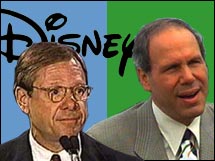|
Tolerating competing agendas
It's why Eisner and Ovitz became one of the most famously disastrous teams in recent history.
(FORTUNE Magazine) - You don't often find examples of the best and worst executive teams involving the same person, but consider the case of Michael Eisner. For the first ten years of his reign at Disney, he and COO Frank Wells formed one of corporate America's great teams. On their watch, Disney (Research) revived its glorious animation tradition, and the movie business flourished. Eisner and Wells could take credit for saving a storied company - and making shareholders rich. This productive partnership ended suddenly and terribly when Wells died in a 1994 helicopter crash.
Eisner then formed one of the most famously disastrous teams in recent history, bringing in uber-agent Michael Ovitz as president. He lasted only 14 months. In the extensive postmortems, the overriding theme is of conflicting business and personal agendas. Ovitz wanted to buy a major stake in Yahoo (Research), expand Disney's book and record businesses, and buy an NFL franchise, among other big ideas that Eisner dismissed as off-strategy. Ovitz also seemed to have notions of his own future - he spent $2 million remodeling his office - that did not sit well with Eisner. Bottom line: team failure, at tremendous cost to Disney in both money and prestige. It is many a father's dream to team up with his sons, but family businesses can find it particularly difficult to unpick the personal from the corporate. That is one part of the dynamic that operated at Adelphia, the cable company founded by John Rigas. Even after it went public, Rigas and his sons operated it as if were still a family concern - for example, paying for private expenses from corporate funds. They got nailed, and Adelphia went bankrupt in 2002. The challenge is to keep the inevitable personal agendas from becoming destructive. That's part of the leader's job. For example, Ameritech in the '90s had an all-star team of top executives that included Richard Notebaert, future CEO of Ameritech, Tellabs, and Qwest, and Richard Brown, future CEO of Cable & Wireless and EDS. Michigan business school professor Noel Tichy, who was advising the company on leadership development at the time, recalls that CEO Bill Weiss told the team bluntly every week that if he caught anybody trying to undermine the others, the guilty party would be fired. It worked. Next pitfall: Letting conflicts fester --------------- Why dream teams fail:
|
|

